Mailinmypocket
International Hazard
    
Posts: 1351
Registered: 12-5-2011
Member Is Offline
Mood: No Mood
|
|
Silicon Tetrafluoride - "Sand Gas"
I found an old article relating to fluorides (see here http://www.sciencemadness.org/talk/viewthread.php?tid=8 ) and in it there is an experiment in making silicon tetrafluoride, they call it "sand
gas" because it becomes silicic acid on contact with water.
The vague instructions call for equal amounts of a fluoride (CaF, NaF, etc) and sand, as well as con. sulfuric acid.
I wanted to try and make some of this silicon tetrafluoride, it turns out it is a very neat experiment but I had to abort it due to excessive foaming
and fumes...
I collected 100ml of the gas and then let some flow into a glass of water. Instantly a skin of silicic acid appeared on the surface of the water and
walls of the glass.
I stopped the experiment because there were more fumes than expected and the fear of fluorides got the best of me. I stored some of the gas in a
plastic container and if I wet a glass rod and stick it into the atmosphere within the container it almost instantly solidifies due to a thick silicic
acid skin.
A fun experiment but be careful...
Opted to use calcium fluoride
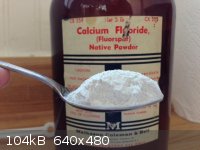
Calcium fluoride and builders sand, mixed with sulfuric acid added. The mixture was slowly bubbling even without heat.
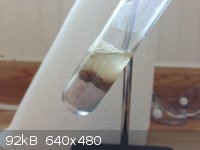
After "dumping" the fumes into a glass of water...
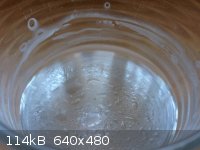
The article where this "safe" idea came from... See full 4 pages at the link I posted above.
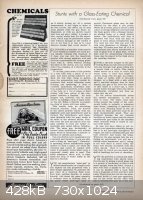
[Edited on 26-11-2012 by Mailinmypocket]
|
|
|
garage chemist
chemical wizard
    
Posts: 1803
Registered: 16-8-2004
Location: Germany
Member Is Offline
Mood: No Mood
|
|
Good job on replicating and documenting an experiment from Scientific American.
I think SiF4 is a unique substance as it reacts to produce a rigid gel upon contact with water. The gel is so rigid that bubbling SiF4 gas into water
actually produces a "tube" extending to the surface that prevents its complete reaction with water. Can you think of any other substance that does
this?
This, together with its very simple production and the fact that it actually doesn't attack glass, gives potential for spectacular experiments.
|
|
|
Mailinmypocket
International Hazard
    
Posts: 1351
Registered: 12-5-2011
Member Is Offline
Mood: No Mood
|
|
Quote: Originally posted by garage chemist  | Good job on replicating and documenting an experiment from Scientific American.
I think SiF4 is a unique substance as it reacts to produce a rigid gel upon contact with water. The gel is so rigid that bubbling SiF4 gas into water
actually produces a "tube" extending to the surface that prevents its complete reaction with water. Can you think of any other substance that does
this?
This, together with its very simple production and the fact that it actually doesn't attack glass, gives potential for spectacular experiments.
|
It really is amazing how the test tube is completely unharmed. When I first started to see white fumes of silicic acid (and perhaps HF?) it took me a
moment to grab the PE jar and start collecting the gas. During this time the gas exiting the tube started to create icicle-like formations at the end
of the exit tube! Unfortunately I forgot to take pictures of those.
This material seems to have lots of potential as far as experiments go, it seems easy to store in a very dry container too.
I was in the process of making an apparatus to have the gas bubble vertically up through water to try and create tubes of silicic acid. After making
the perfect piece of glass tube for the job I managed to jam myself in the palm with it while trying to stick it into a stopper. After picking bits of
glass out of my hand I wasn't in the mood to try the experiment again (today anyways  ) )
A nice small, but deep hand stab, huzzah! What a stupid mistake.
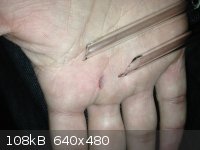
[Edited on 26-11-2012 by Mailinmypocket]
|
|
|
garage chemist
chemical wizard
    
Posts: 1803
Registered: 16-8-2004
Location: Germany
Member Is Offline
Mood: No Mood
|
|
Ouch. Are you using rubber stoppers or do you have Quickfit joint adapters?
I cannot help but wonder what it would look like to open a compressed gas cylinder of SiF4 and throw it into a shallow lake.
Branched tubes of silica would grow from the cylinder outwards towards the surface of the water. A chemical garden with gas instead of salts, and in
extra rapid mode!
|
|
|
Mailinmypocket
International Hazard
    
Posts: 1351
Registered: 12-5-2011
Member Is Offline
Mood: No Mood
|
|
Quote: Originally posted by garage chemist  | Ouch. Are you using rubber stoppers or do you have Quickfit joint adapters?
I cannot help but wonder what it would look like to open a compressed gas cylinder of SiF4 and throw it into a shallow lake.
Branched tubes of silica would grow from the cylinder outwards towards the surface of the water. A chemical garden with gas instead of salts, and in
extra rapid mode! |
For this I was using rubber stoppers, too afraid to use fluorides in my Quickfit stuff, even SiF4. Next time I will just be more careful and probably
bubble it from below a layer of mercury in a column so that the tube doesn't block with silicic acid. The rubber stopper was completely unaffected
after the experiment. Only white deposits that you can wipe off by hand. Pisses me off because I had the perfect tube for the job 
If you were to grow them (using compressed SiF4) using aqueous solutions of fluorescent dyes such as rhodamine or fluorescein you could create some
cool formations. Depending on how solid they are.
[Edited on 26-11-2012 by Mailinmypocket]
[Edited on 26-11-2012 by Mailinmypocket]
|
|
|
MrHomeScientist
International Hazard
    
Posts: 1806
Registered: 24-10-2010
Location: Flerovium
Member Is Offline
Mood: No Mood
|
|
Periodicvideos on Youtube has a good video about your mishap, Mailinmypocket, if you hadn't seen it. They call that injury the "mark of the chemist"

<iframe sandbox width="560" height="315" src="http://www.youtube.com/embed/Wn9qxPKkRDw" frameborder="0" allowfullscreen></iframe>
|
|
|
Mailinmypocket
International Hazard
    
Posts: 1351
Registered: 12-5-2011
Member Is Offline
Mood: No Mood
|
|
I was thinking of that periodicvideo while applying pressure to the wound haha! I guess I am now marked.
This morning I wanted to play with this strange gas again. Instead of just letting the tube exit into open air I used a piece of bent glass tube
(broken from last night) and placed it so that the tube was just above the water surface.
The mix was used with a higher proportion of sand to discourage any HF from attacking the test tube instead. As soon as the gas evolution started the
beaker fogged up and a gel like layer started growing quite quickly on the surface of the water like an island. Not the whole surface of the water
became covered though so the SiF4 seems to be highly attracted to the water. It doesn't seem to float around in the beaker much.
Draping a very wet paper towel over the beaker completely prevented any fumes from escaping and at the end of the experiment the paper had a layer of
snow like deposit on it.
Another interesting observation is if a jar of the gas is suddenly inverted over water and kept about 5mm from the surface, the surface instantly
solidifies and makes a crackly sound!
My crude set up
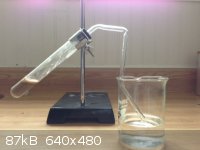 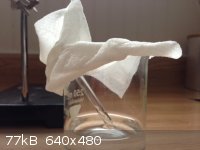
Water surface as seen from below and above, after there was no more SiF4 being generated.
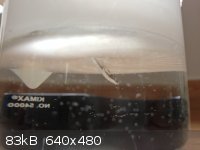 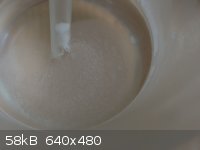
This time the layer was so thick it could easily be skimmed off. The consistency was similar to jell-o
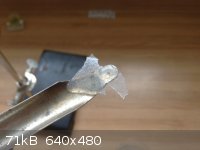
|
|
|
woelen
Super Administrator
        
Posts: 7976
Registered: 20-8-2005
Location: Netherlands
Member Is Offline
Mood: interested
|
|
This all looks very very interesting. I, however, have seen this kind of behavior also with SiH4. I once made SiH4 and bubbled that gas in an inverted
test tube above water. SiH4 does not react with water at once, but when I came back to the test tube a few days later, I saw that the water inside was
covered by a thin milky layer which was strong enough to keep the test tube nearly horizontal before the layer broke apart. But the SiF4 experiments
seem to be more impressive (SiH4 is impressive in another way, because of its self-igniting properties, as soon as it comes in contact with air).
|
|
|
Mailinmypocket
International Hazard
    
Posts: 1351
Registered: 12-5-2011
Member Is Offline
Mood: No Mood
|
|
Quote: Originally posted by woelen  | | This all looks very very interesting. I, however, have seen this kind of behavior also with SiH4. I once made SiH4 and bubbled that gas in an inverted
test tube above water. SiH4 does not react with water at once, but when I came back to the test tube a few days later, I saw that the water inside was
covered by a thin milky layer which was strong enough to keep the test tube nearly horizontal before the layer broke apart. But the SiF4 experiments
seem to be more impressive (SiH4 is impressive in another way, because of its self-igniting properties, as soon as it comes in contact with air).
|
Yes I have seen your page on silane along with the image of the said skin over the water in the test tube. I am thinking that this is the same skin of
silicic acid as is produced from SiF4, a quick read about SiH4 on Wikipedia revealed this in the "safety" section:
"In addition, contact with eyes may form silicic acid with resultant irritation"
So it might be possible that both gases react with water to form the same substance, SiF4 just seems like it does it faster.
I want to try two more experiments; one in which I slowly release the gas from a tube positioned over a steaming beaker of water to see if I can get
"growths" on the end of the tube due to the high water content of the surrounding atmosphere (although the rising steam may just carry the gas up with
it.) Second, I would like to add an acid base indicator to the water to see what effects the reaction has on the water. I am expecting to see acid
forming near the surface due to HF.
All in all a fun stuff to experiment with, and no glassware damage 
[Edited on 27-11-2012 by Mailinmypocket]
|
|
|
tetrahedron
Hazard to Others
  
Posts: 210
Registered: 28-9-2012
Member Is Offline
Mood: No Mood
|
|
this injury (eerily exactly described in the video) actually stopped me experimenting for a long time. i'm relieved to hear now it's actually a very
common mark among chemists and to be worn with pride =D
|
|
|
blogfast25
International Hazard
    
Posts: 10562
Registered: 3-2-2008
Location: Neverland
Member Is Offline
Mood: No Mood
|
|
I just hope people here understand what a nasty little chemical SiF4 really is: hydrolysis generates HF. Beware!
See this SiF4 MSDS and start shivering:
http://www.orcbs.msu.edu/msds/LINDE_MSDS/pdf/061.pdf
[Edited on 27-11-2012 by blogfast25]
|
|
|
Mailinmypocket
International Hazard
    
Posts: 1351
Registered: 12-5-2011
Member Is Offline
Mood: No Mood
|
|
Absolutely - The first time I ran this experiment I stopped it right away because of the fumes that are VERY noticeable. The old papers don't
highlight much about safety I must admit. As soon as I caught a whiff of what smelled exactly like conc HCL fumes I left the room, stopped heating and
took the apparatus outside. Just smelling that pungent odor and knowing that it IS NOT HCl got the adrenaline flowing.
Draping a very wet paper towel over whatever vessel you plan on venting the gas into seems to work quite well, no fugitive fumes at all. Still, be
careful. I rarely experiment with fluorides, let alone volatile ones that hydrolyse to HF and if inhaled would deposit silicic acid in your lungs,
along with the HF exposure.
Unfortunately, although the gas does not affect dry glass, it does affect wet glass. The beaker I used in the previous experiment has dried after
cleaning and there is a white ring where the water level was  It would seem that
due to the hydrolysis to HF, if there is a thin coating of water enough is produced in high enough concentrations in those areas to etch the glass. Do
not do this with glass you like... This was a brand new beaker. It would seem that
due to the hydrolysis to HF, if there is a thin coating of water enough is produced in high enough concentrations in those areas to etch the glass. Do
not do this with glass you like... This was a brand new beaker.
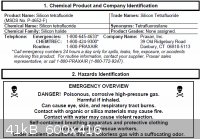
[Edited on 27-11-2012 by Mailinmypocket]
[Edited on 27-11-2012 by Mailinmypocket]
|
|
|
garage chemist
chemical wizard
    
Posts: 1803
Registered: 16-8-2004
Location: Germany
Member Is Offline
Mood: No Mood
|
|
SiF4 doesn't form HF upon reaction with water.
The reaction goes:
3 SiF4 + 2 H2O ---> 2 H2SiF6 + SiO2
The white ring on your beaker must be adhering silica, because H2SiF6 does not noticeably attack glass. It's also not nearly as dangerous as HF,
though it's a much stronger acid.
SiF4 is still very toxic upon inhalation, but not because of HF formation.
|
|
|
Mailinmypocket
International Hazard
    
Posts: 1351
Registered: 12-5-2011
Member Is Offline
Mood: No Mood
|
|
Quote: Originally posted by garage chemist  | SiF4 doesn't form HF upon reaction with water.
The reaction goes:
3 SiF4 + 2 H2O ---> 2 H2SiF6 + SiO2
The white ring on your beaker must be adhering silica, because H2SiF6 does not noticeably attack glass. It's also not nearly as dangerous as HF,
though it's a much stronger acid.
SiF4 is still very toxic upon inhalation, but not because of HF formation.
|
You sure? I have tried using steel wool and it still won't come off. Upon hydrolysis wouldn't the HF formed have the ability to perhaps etch the glass
a bit? How do you suggest I remove this stuff if otherwise?
[Edited on 27-11-2012 by Mailinmypocket]
|
|
|
garage chemist
chemical wizard
    
Posts: 1803
Registered: 16-8-2004
Location: Germany
Member Is Offline
Mood: No Mood
|
|
Try NaOH solution, warm or hot if necessary.
How would it be possible for HF to exist in the presence of finely divided silicic acid, which the hydrolysis of SiF4 produces? It's not possible, and
there simply isn't any free HF present in the hydrolysis products of SiF4.
|
|
|
blogfast25
International Hazard
    
Posts: 10562
Registered: 3-2-2008
Location: Neverland
Member Is Offline
Mood: No Mood
|
|
Quote: Originally posted by garage chemist  | SiF4 doesn't form HF upon reaction with water.
The reaction goes:
3 SiF4 + 2 H2O ---> 2 H2SiF6 + SiO2
The white ring on your beaker must be adhering silica, because H2SiF6 does not noticeably attack glass. It's also not nearly as dangerous as HF,
though it's a much stronger acid.
SiF4 is still very toxic upon inhalation, but not because of HF formation.
|
I think you’re oversimplifying. My A.F.Holleman (‘Inorganic Chemistry’) mentions very clearly that dilute solutions of H2SiF6 on mild heating
contain much more HF in their vapours than than they do SiF4. That shows that H2SiF6 really exists as an equilibrium:
H2SiF6 < === > 2 HF + SiF4
According to the same source, a solution of 13.3 % H2SiF6 has a vapour composition of 2 HF + 1 SiF4 (2:1 molar ratio). For those reasons, H2SiF6 is
difficult to isolate although a solid hydrate H2SiF6.2H2O (MP = 19 C) does appear to exist.
Hexafluorosilicates are also ‘imperfect complexes’: their anions are partly dissociated, similar to hexachlorostannates (for instance).
SiF4 and H2SiF6 may be less dangerous than HF but remain seriously dangerous chemicals.
[Edited on 27-11-2012 by blogfast25]
|
|
|
feacetech
Hazard to Others
  
Posts: 163
Registered: 12-2-2007
Member Is Offline
Mood: No Mood
|
|
All of this sounds very similar to the prodcution of superphosphate and the flouride byproducts
below is an edited extract from a literature review of fluoride managment during SSP production
"The exact chemistry of the reaction between sulphuric acid and phosphate rock is not precisely understood due to the unknown composition of phosphate
rock. The simplified reaction of fluorapatite and sulphuric acid is commonly used as a good representation of this process. In this process sulphuric
acid reacts with the fluorapatite to form phosphoric acid, calcium sulphate and a fluoride based compound. The phosphoric acid goes on to react with
another fluorapatite molecule to form monocalcium phosphate and an additional fluoride compound. This process can be seen below;
2{3[Ca3(PO4)].CaF2} + 18H2SO4 → 18CaSO4 + 12H3PO4 + 2CaF2
3[Ca3(PO4)].CaF2 + 12H3PO4 → 9Ca(H2PO4)2 + CaF2
3CaF2 + 3H2SO4 → 3CaSO4 + 6HF
9Ca(H2PO4)2 + 9H2O → 3Ca(H2PO4)2.H2O
21CaSO4 + 42H2O → 6CaSO4.2H2O
3[Ca3(PO4)].CaF2 + 7H2SO4 + 17H2O → 3Ca(H2PO4)2.H2O + 7CaSO4.2H2O + 2HF
The current mechanism of fluoride evolution is the production of hydrogen fluoride from the reaction of fluorapatite and sulphuric acid. It has then
been suggested that the hydrogen fluoride gas is initially converted into hydrofluoric acid. A reaction then occurs with the silicates in the
phosphate rock to form silicon tetrafluoride. This reaction can be seen in the 2 equaitons below where M2SiO3 represents the silica based compounds.
6HF → 3H2F2
M2SiO3 + 3H2F2 → SiF4 + M2F2 + 3H2O
there is only partial volatilisation of fluoride and it is predominantly in the form of silicon tetrafluoride. This is assuming there is a high rate
of conversion from hydrogen fluoride to hydrofluoric acid
The established set of reactions with hydrogen fluoride as an intermediate product has been put under dispute. It was found the reaction between
concentrated hydrofluoric acid and silicates are usually very slow; therefore, there should be more hydrofluoric acid present in the gas evolved. It
was even found that hydrofluoric acid reacts with the fluorapatite to form available phosphate rather than with the silica to enhance the
volatilisation of fluorine as seen below. These results also coincide with experiments completed where quartz flour and other silicates were added to
low silica phosphate rocks where it was found that there was no increase in the fluorine volatilisation. Also with experiments where 12% hydrogen
fluoride was directly added to the process and there was no increase in fluoride evolution observed. It has been said it is more likely that silicon
tetrafluoride is directly produced but there are currently no reaction pathways which detail this process
Ca10(PO4)6F2 + 10H2F2 → 6H3PO4 + 10CaF2 + 2HF
An experiment was completed which showed that the addition of calcium fluosilicate increases the evolution of the total fluoride evolution. The
percentage of total fluoride evolution remained very consistent between 35.4-35.9%. This indicates that the level of fluoride evolution is directly
related to the presence of calcium flurosilicate compounds. It was concluded that fluorine evolution behaves like hexafluorosilicic acid and not like
hydrofluoric acid.
Fluoride evolution is the main by-product from the production of superphospahte. The majority of the fluoride is evolved from the initial reaction of
phosphate rock with sulphuric acid in the form of silicon tetrafluoride. The silicon tetrafluoride vapours are then run through a wet scrubbing system
in the presence of excess water. It is generally accepted that the silicon tetrafluoride is hydrolysed to form HFA and silicon dioxide. This reaction
has even been shown to take place within the reaction chamber as there is an excess of water vapour present with the silicon tetrafluoride. There has
been a wide variety of different reactions which have been shown to form the HFA and silica based products as seen in below. The first three reactions
agree on the formation of HFA but differ in the type of silica molecule that will be formed. Three different types of silica have been hypothesised to
form they are silicon dioxide (SiO2), hydrated silicon dioxide (SiO2.2H2O) and silicon hydroxide (Si(OH)4) below. Most workers have cited at least one
of these reactions but no experimental evidence has been produced.
3SiF4 + 2H2O → 2H2SiF6 + SiO2
3SiF4 + 4H2O → 2H2SiF6 + SiO2.2H2O
3SiF4 + 4H2O → 2H2SiF6 + Si(OH)4
It has also been noted that when silicon levels are high fluodisilicic acid (H2SiF6.SiF4) is formed in equilibrium with HFA in solution. In this case
the silicon tetrafluoride is thought to be hydrolysed the reaction expressed below.
(3+2n)SiF4 + 2H2O → 2H2SiF6.nSiF4 + SiO2
Any of these reactions are possible. There has been insufficient experimental work completed; therefore, it can not be said which ones take place. It
has even been hypothesised that each of the reactions will occur depending on the reaction conditions, such as, temperature, pressure, pH and many
others. A significant amount of work has been completed on the gaseous phase reaction between silicon tetrafluoride and water which is often used in
the production of high purity amorphous silicon and silicon dioxide fibres . It was stated that other chemicals besides HFA are formed during the
hydrolysis of SiF4. These include hexafluorodisiloxane (SiOF6) and perfluorotrisiloxane (Si3O2F8). Mass spectrometer readings showed that the compound
SiF3OSiF2OSiF3 was present. The Majority of this research is not applicable to the wet scrubbing system used in the production of SSP. This is because
reactions are completed at temperatures often above 200°C and are completed with an excess of silicon tetrafluoride and extremely low concentration
of oxygen and hydrogen. There was a study completed that examined the gaseous phase reaction between silicon tetrafluoride and water at atmospheric
conditions. This was completed because of the potential for the formation of hydrogen fluoride which poses a safety risk. This work may relate to the
conditions found above the reaction of phosphate rock and sulphuric acid. The reactions put forward are shown below. The results from this work
concluded that hydrogen fluoride is not produced during the exposure of silicon tetrafluoride to humid air. An unidentified hydrolysed compound was
produced.
4SiF4 + 2H2O → 2(F3Si)2O + 4HF
2SiF4 + 2H2O → H2SiF6 + SiO2 + 2HF
SiF4 + 2H2O → SiO2 + 4HF
A solution is produced from the hydrolysation of silicon tetrafluoride during the production of Superphosphate this is mainly comprised of HFA
(H2SiF6) and silicon dioxide (SiO2) in solution with water. It has been shown by several workers to be an inaccurate simplification. This is because
the scrubber liquor has been found to have a fluoride to silica ratio (F:Si) of 4.7-5.35. The ratio is significantly lower than the F:Si ratio of 6 of
pure HFA. Several workers have stated that the low ratio is due to the formation fluodisilicic acid (H2SiF6.SiF4) which is present in a state of
equilibrium with the HFA compound. The equilibrium position is mainly influenced by the concentration of fluoride ions. This hypothesis does hold as
the properties and composition of the solution act as a mixture of HFA and hydrated SiF4.2H2O. It has also been proposed that the species SiF5- is in
equilibrium with SiF4 and SiO2. It has also been stated that the HFA may be present in either mono-, di-, and tetra-, forms of hydration. A
significant amount of work has been completed relating to the vapour pressure and vapour phase composition of scrubber liquor solution and pure HFA.
Several experiments were completed to examine the volatility of HFA. It was found that when HFA was heated a distillate of higher concentration could
be produced. It was identified that this could be due to the volatilisation of HFA or the decomposition by means of the reaction shown below.
Additional experiments were completed where the HFA was again heated, but the vapour produced were passed through glass fibre which would adsorb the
hydrogen fluoride, if it was present. In this experiment no distillate was produced regardless of the condenser temperature. A similar experiment was
then completed where the humid air was added to the receiver vessel and a distillate containing HFA was again formed. It was therefore concluded from
these experiments that HFA is a non-volatile acid similar to sulphuric acid, and cannot exist under ordinary conditions in the vapour state. This
means pure HFA cannot be isolated as it decomposes to silicon tetrafluoride and hydrogen fluoride.
H2SiF6 → SiF4 + 2HF
It was also noted in the experiments that vessels which contained HFA became etched. This was most pronounced at the surface line of the liquid but
there was consistent etching below the liquid level. The etching faded about an inch above the surface of the solution. There was little to no etching
in further vessels which were connected up. It was hypothesised that this process occurred due to the decomposition of HFA to hydrofluoric acid and
silicon tetrafluoride. The hydrofluoric acid rapidly went on to react with the silicon in the glass to form silicon tetrafluoride and water. This
result coincides with the observation that when scrubber liquors contain high levels of silica the vapour phase will be rich in silicon tetrafluoride.
This is compared to the solutions used inother experiments, which were low in silica, so formed elevated levels of hydrofluoric acid that went on to
react with the silica in the glass. These results are significant to the process because this explains the relatively low levels hydrogen fluoride
found within the fluoride vapour evolved from the phosphate rock and sulphuric acid. This is due to the reaction of hydrogen fluoride with the silica
which is of great abundance within the scrubber liquor.
The affect of variations in the concentration of HFA were also examined. It was found that the maximum practical concentration of HFA within an
industrial scrubbing system was between 22-25%. Above 25-26 wt% it was found that there was a sudden marked change in the character of the suspended
silica. It was found to act as a stiff foam causing rapid expansion in volume. This significantly reduces the efficiency of fluoride scrubbing to a
point where there can be overflow between vessels and a significant reduction in fluoride absorption capacity occurs. Foaming was only found to happen
in a scrubbing system, as it was not found when HFA was concentrated 60.92% at room temperature (20-22°C). It was found that HFA was stable in this
form for long periods of time.
The reaction of HFA and sulphuric acid has been of significant interest since recycling of scrubber liquor was developed. This was developed as a
fluoride management process that reincorporated fluoride, which was initially present within the phosphate rock back into the finally product. It was
found that this resulted in significant re-evolution of fluoride within the process. This is directly attributed to the reaction between sulphuric
acid and HFA due to a clear relationship between several sulphuric acid based factors. Influencing factors included the concentration of sulphuric
acid and proximity of sulphuric acid injection to HFA injection.
There were two main reaction pathways which have been attributed to the model where sulphuric acid is the driving factor for the re-evolution of
fluoride from HFA. This can be seen in the Equations below.
H2SiF6 + 6H2SO4 → 6HSO3F + SiO2 + 4H2O
6HSO3F + 6H2O → 6H2SO4 + 6HF
4HF + SiO2 → SiF4 + 2H2O
H2SiF6 + 2H2SO4 → 2HSO3F + SiF4 + 2H2O
4HSO3F + SiO2 + 2H2O → SiF4 + 4H2SO4
The overall generalised process of sulphuric acid catalysis of HFA decomposition can be seen in the Equation below.
H2SiF6 + 6H2SO4 → 6H2SO4 + 2HF + SiF4
It should be noted that these reactions are purely theoretical and can be rearranged to give the same final product. In all of these reactions
sulphuric acid only acts as a catalyst in the formation of hydrogen fluoride and silicon tetrafluoride from HFA.
Several experiments have been completed on this process with varying results. It has been found that the level of fluoride evolution can vary between
75 and 100% as the fluoride to silica ratio is decreased from 6:1 to 4:1. This relates back to what is seen in the reactions above where they can both
proceed to completion in the presence of excess silica. It is more likely to follow the reactions seen in Equations below
H2SiF6 + 2H2SO4 → 2HSO3F + SiF4 + 2H2O (23)
4HSO3F + SiO2 + 2H2O → SiF4 + 4H2SO4
as the evolution of hydrogen fluoride in the absence of silica is not observed. There is also the alternative possibility that the main reason for
high fluoride re-evolution is due to the heat which is released with the mixing of the HFA and sulphuric acid. It should also be noted that none of
the reactions explain the repeated observation of the formation of voluminous white solid. The solid flows like a gel at the mixing tee of the
sulphuric acid and HFA which suggests a silica or calcium sulphate compound. Considering the amount of research that has been completed on the
recycling of HFA, there is relativity little known about the reactions that govern this process.
It is common practice to recycled HFA back into the reaction of phosphate rock and sulphuric acid. This reaction acts as a means of locking the
fluoride into a solid state which is of negligible environmental effect. It also supplements the use of sulphuric acid as an active hydrogen donating
molecule. Two different reactions between phosphate rock and HFA have been hypothesised. It has been suggested by two separate workers that calcium
hexafluorosilicate, phosphoric acid and hydrogen fluoride are the produced from the reaction between phosphate rock and HFA as seen in the Equation
below. An alternative theory suggests that calcium fluoride, phosphoric acid and silicon dioxide are formed from this reaction as seen in the other
Equation below.
3[Ca3(PO4)2].CaF2 + 10H2SiF6 → 10CaSiF6 + 6H3PO4 + 2HF
3[Ca3(PO4)2].CaF2 + 3H2SiF6 + 6H2O → 10CaF2 + 6H3PO4 + 3SiO2
Both of the above reactions produce phosphoric acid and a compound that traps the fluoride within the solid state. This coincides with the
observations made that the addition of HFA acts to supplement the action of the sulphuric acid as an active hydrogen donating compound to aid in the
acidulation of the phosphate rock. It has also been found that approximately 25% of the recycled fluoride is contained within the final SSP as a solid
compound.
Several workers have found that the solid fluoride based product was in the form of calcium fluoride. It was also found by another worker that when
phosphate rock was reacted with the scrubbing liquor, only 85% of the stoichiometric portion of the rock could be added before an extremely voluminous
precipitation of silica was formed. It was found that there is a clear reduction in the vapour pressure of fluoride above scrubber liquor with the
increased proportion of phosphate rock. All of these observations indicate that the reaction shown in the Equation below is the most likely to occur.
It was stated that further analysis is required to be completed on the reaction between phosphate rock and HFA.
3[Ca3(PO4)2].CaF2 + 3H2SiF6 + 6H2O → 10CaF2 + 6H3PO4 + 3SiO2"
hopefully some of this information may be usefull for you current or future experiments
[Edited on 28-11-2012 by feacetech]
|
|
|
woelen
Super Administrator
        
Posts: 7976
Registered: 20-8-2005
Location: Netherlands
Member Is Offline
Mood: interested
|
|
I have to agree with blogfast25. Hexafluorosilicate does form HF under certain conditions and it is capable of attacking glass. Not very strongly, but
still noticeable. I heated an acidified solution of (NH4)2SiF6 in a test tube and afterwards, the test tube is slightly frosty when it becomes dry.
So, I can imagine that putting SiF4 in a glass beaker above some water may result in damage. This is the main reason why I still did not do these
experiments, they sound fascinating, but I value my glassware too much. I'll wait until I have some old small glass household jar or something like
that which may be discarded after the experiments. I also have a few thin glass tubes, used for all kinds of gas-experiments and I also am quite
hesitant to use these tubes for experiments with SiF4.
|
|
|
Mailinmypocket
International Hazard
    
Posts: 1351
Registered: 12-5-2011
Member Is Offline
Mood: No Mood
|
|
Quote: Originally posted by feacetech  | All of this sounds very similar to the prodcution of superphosphate and the flouride byproducts
below is an edited extract from a literature review of fluoride managment during SSP production
"The exact chemistry of the reaction between sulphuric acid and phosphate rock is not precisely understood due to the unknown composition of phosphate
rock. The simplified reaction of fluorapatite and sulphuric acid is commonly used as a good representation of this process. In this process sulphuric
acid reacts with the fluorapatite to form phosphoric acid, calcium sulphate and a fluoride based compound. The phosphoric acid goes on to react with
another fluorapatite molecule to form monocalcium phosphate and an additional fluoride compound. This process can be seen below;
2{3[Ca3(PO4)].CaF2} + 18H2SO4 → 18CaSO4 + 12H3PO4 + 2CaF2
3[Ca3(PO4)].CaF2 + 12H3PO4 → 9Ca(H2PO4)2 + CaF2
3CaF2 + 3H2SO4 → 3CaSO4 + 6HF
9Ca(H2PO4)2 + 9H2O → 3Ca(H2PO4)2.H2O
21CaSO4 + 42H2O → 6CaSO4.2H2O
3[Ca3(PO4)].CaF2 + 7H2SO4 + 17H2O → 3Ca(H2PO4)2.H2O + 7CaSO4.2H2O + 2HF
The current mechanism of fluoride evolution is the production of hydrogen fluoride from the reaction of fluorapatite and sulphuric acid. It has then
been suggested that the hydrogen fluoride gas is initially converted into hydrofluoric acid. A reaction then occurs with the silicates in the
phosphate rock to form silicon tetrafluoride. This reaction can be seen in the 2 equaitons below where M2SiO3 represents the silica based compounds.
6HF → 3H2F2
M2SiO3 + 3H2F2 → SiF4 + M2F2 + 3H2O
there is only partial volatilisation of fluoride and it is predominantly in the form of silicon tetrafluoride. This is assuming there is a high rate
of conversion from hydrogen fluoride to hydrofluoric acid
The established set of reactions with hydrogen fluoride as an intermediate product has been put under dispute. It was found the reaction between
concentrated hydrofluoric acid and silicates are usually very slow; therefore, there should be more hydrofluoric acid present in the gas evolved. It
was even found that hydrofluoric acid reacts with the fluorapatite to form available phosphate rather than with the silica to enhance the
volatilisation of fluorine as seen below. These results also coincide with experiments completed where quartz flour and other silicates were added to
low silica phosphate rocks where it was found that there was no increase in the fluorine volatilisation. Also with experiments where 12% hydrogen
fluoride was directly added to the process and there was no increase in fluoride evolution observed. It has been said it is more likely that silicon
tetrafluoride is directly produced but there are currently no reaction pathways which detail this process
Ca10(PO4)6F2 + 10H2F2 → 6H3PO4 + 10CaF2 + 2HF
An experiment was completed which showed that the addition of calcium fluosilicate increases the evolution of the total fluoride evolution. The
percentage of total fluoride evolution remained very consistent between 35.4-35.9%. This indicates that the level of fluoride evolution is directly
related to the presence of calcium flurosilicate compounds. It was concluded that fluorine evolution behaves like hexafluorosilicic acid and not like
hydrofluoric acid.
Fluoride evolution is the main by-product from the production of superphospahte. The majority of the fluoride is evolved from the initial reaction of
phosphate rock with sulphuric acid in the form of silicon tetrafluoride. The silicon tetrafluoride vapours are then run through a wet scrubbing system
in the presence of excess water. It is generally accepted that the silicon tetrafluoride is hydrolysed to form HFA and silicon dioxide. This reaction
has even been shown to take place within the reaction chamber as there is an excess of water vapour present with the silicon tetrafluoride. There has
been a wide variety of different reactions which have been shown to form the HFA and silica based products as seen in below. The first three reactions
agree on the formation of HFA but differ in the type of silica molecule that will be formed. Three different types of silica have been hypothesised to
form they are silicon dioxide (SiO2), hydrated silicon dioxide (SiO2.2H2O) and silicon hydroxide (Si(OH)4) below. Most workers have cited at least one
of these reactions but no experimental evidence has been produced.
3SiF4 + 2H2O → 2H2SiF6 + SiO2
3SiF4 + 4H2O → 2H2SiF6 + SiO2.2H2O
3SiF4 + 4H2O → 2H2SiF6 + Si(OH)4
It has also been noted that when silicon levels are high fluodisilicic acid (H2SiF6.SiF4) is formed in equilibrium with HFA in solution. In this case
the silicon tetrafluoride is thought to be hydrolysed the reaction expressed below.
(3+2n)SiF4 + 2H2O → 2H2SiF6.nSiF4 + SiO2
Any of these reactions are possible. There has been insufficient experimental work completed; therefore, it can not be said which ones take place. It
has even been hypothesised that each of the reactions will occur depending on the reaction conditions, such as, temperature, pressure, pH and many
others. A significant amount of work has been completed on the gaseous phase reaction between silicon tetrafluoride and water which is often used in
the production of high purity amorphous silicon and silicon dioxide fibres . It was stated that other chemicals besides HFA are formed during the
hydrolysis of SiF4. These include hexafluorodisiloxane (SiOF6) and perfluorotrisiloxane (Si3O2F8). Mass spectrometer readings showed that the compound
SiF3OSiF2OSiF3 was present. The Majority of this research is not applicable to the wet scrubbing system used in the production of SSP. This is because
reactions are completed at temperatures often above 200°C and are completed with an excess of silicon tetrafluoride and extremely low concentration
of oxygen and hydrogen. There was a study completed that examined the gaseous phase reaction between silicon tetrafluoride and water at atmospheric
conditions. This was completed because of the potential for the formation of hydrogen fluoride which poses a safety risk. This work may relate to the
conditions found above the reaction of phosphate rock and sulphuric acid. The reactions put forward are shown below. The results from this work
concluded that hydrogen fluoride is not produced during the exposure of silicon tetrafluoride to humid air. An unidentified hydrolysed compound was
produced.
4SiF4 + 2H2O → 2(F3Si)2O + 4HF
2SiF4 + 2H2O → H2SiF6 + SiO2 + 2HF
SiF4 + 2H2O → SiO2 + 4HF
A solution is produced from the hydrolysation of silicon tetrafluoride during the production of Superphosphate this is mainly comprised of HFA
(H2SiF6) and silicon dioxide (SiO2) in solution with water. It has been shown by several workers to be an inaccurate simplification. This is because
the scrubber liquor has been found to have a fluoride to silica ratio (F:Si) of 4.7-5.35. The ratio is significantly lower than the F:Si ratio of 6 of
pure HFA. Several workers have stated that the low ratio is due to the formation fluodisilicic acid (H2SiF6.SiF4) which is present in a state of
equilibrium with the HFA compound. The equilibrium position is mainly influenced by the concentration of fluoride ions. This hypothesis does hold as
the properties and composition of the solution act as a mixture of HFA and hydrated SiF4.2H2O. It has also been proposed that the species SiF5- is in
equilibrium with SiF4 and SiO2. It has also been stated that the HFA may be present in either mono-, di-, and tetra-, forms of hydration. A
significant amount of work has been completed relating to the vapour pressure and vapour phase composition of scrubber liquor solution and pure HFA.
Several experiments were completed to examine the volatility of HFA. It was found that when HFA was heated a distillate of higher concentration could
be produced. It was identified that this could be due to the volatilisation of HFA or the decomposition by means of the reaction shown below.
Additional experiments were completed where the HFA was again heated, but the vapour produced were passed through glass fibre which would adsorb the
hydrogen fluoride, if it was present. In this experiment no distillate was produced regardless of the condenser temperature. A similar experiment was
then completed where the humid air was added to the receiver vessel and a distillate containing HFA was again formed. It was therefore concluded from
these experiments that HFA is a non-volatile acid similar to sulphuric acid, and cannot exist under ordinary conditions in the vapour state. This
means pure HFA cannot be isolated as it decomposes to silicon tetrafluoride and hydrogen fluoride.
H2SiF6 → SiF4 + 2HF
It was also noted in the experiments that vessels which contained HFA became etched. This was most pronounced at the surface line of the liquid but
there was consistent etching below the liquid level. The etching faded about an inch above the surface of the solution. There was little to no etching
in further vessels which were connected up. It was hypothesised that this process occurred due to the decomposition of HFA to hydrofluoric acid and
silicon tetrafluoride. The hydrofluoric acid rapidly went on to react with the silicon in the glass to form silicon tetrafluoride and water. This
result coincides with the observation that when scrubber liquors contain high levels of silica the vapour phase will be rich in silicon tetrafluoride.
This is compared to the solutions used inother experiments, which were low in silica, so formed elevated levels of hydrofluoric acid that went on to
react with the silica in the glass. These results are significant to the process because this explains the relatively low levels hydrogen fluoride
found within the fluoride vapour evolved from the phosphate rock and sulphuric acid. This is due to the reaction of hydrogen fluoride with the silica
which is of great abundance within the scrubber liquor.
The affect of variations in the concentration of HFA were also examined. It was found that the maximum practical concentration of HFA within an
industrial scrubbing system was between 22-25%. Above 25-26 wt% it was found that there was a sudden marked change in the character of the suspended
silica. It was found to act as a stiff foam causing rapid expansion in volume. This significantly reduces the efficiency of fluoride scrubbing to a
point where there can be overflow between vessels and a significant reduction in fluoride absorption capacity occurs. Foaming was only found to happen
in a scrubbing system, as it was not found when HFA was concentrated 60.92% at room temperature (20-22°C). It was found that HFA was stable in this
form for long periods of time.
The reaction of HFA and sulphuric acid has been of significant interest since recycling of scrubber liquor was developed. This was developed as a
fluoride management process that reincorporated fluoride, which was initially present within the phosphate rock back into the finally product. It was
found that this resulted in significant re-evolution of fluoride within the process. This is directly attributed to the reaction between sulphuric
acid and HFA due to a clear relationship between several sulphuric acid based factors. Influencing factors included the concentration of sulphuric
acid and proximity of sulphuric acid injection to HFA injection.
There were two main reaction pathways which have been attributed to the model where sulphuric acid is the driving factor for the re-evolution of
fluoride from HFA. This can be seen in the Equations below.
H2SiF6 + 6H2SO4 → 6HSO3F + SiO2 + 4H2O
6HSO3F + 6H2O → 6H2SO4 + 6HF
4HF + SiO2 → SiF4 + 2H2O
H2SiF6 + 2H2SO4 → 2HSO3F + SiF4 + 2H2O
4HSO3F + SiO2 + 2H2O → SiF4 + 4H2SO4
The overall generalised process of sulphuric acid catalysis of HFA decomposition can be seen in the Equation below.
H2SiF6 + 6H2SO4 → 6H2SO4 + 2HF + SiF4
It should be noted that these reactions are purely theoretical and can be rearranged to give the same final product. In all of these reactions
sulphuric acid only acts as a catalyst in the formation of hydrogen fluoride and silicon tetrafluoride from HFA.
Several experiments have been completed on this process with varying results. It has been found that the level of fluoride evolution can vary between
75 and 100% as the fluoride to silica ratio is decreased from 6:1 to 4:1. This relates back to what is seen in the reactions above where they can both
proceed to completion in the presence of excess silica. It is more likely to follow the reactions seen in Equations below
H2SiF6 + 2H2SO4 → 2HSO3F + SiF4 + 2H2O (23)
4HSO3F + SiO2 + 2H2O → SiF4 + 4H2SO4
as the evolution of hydrogen fluoride in the absence of silica is not observed. There is also the alternative possibility that the main reason for
high fluoride re-evolution is due to the heat which is released with the mixing of the HFA and sulphuric acid. It should also be noted that none of
the reactions explain the repeated observation of the formation of voluminous white solid. The solid flows like a gel at the mixing tee of the
sulphuric acid and HFA which suggests a silica or calcium sulphate compound. Considering the amount of research that has been completed on the
recycling of HFA, there is relativity little known about the reactions that govern this process.
It is common practice to recycled HFA back into the reaction of phosphate rock and sulphuric acid. This reaction acts as a means of locking the
fluoride into a solid state which is of negligible environmental effect. It also supplements the use of sulphuric acid as an active hydrogen donating
molecule. Two different reactions between phosphate rock and HFA have been hypothesised. It has been suggested by two separate workers that calcium
hexafluorosilicate, phosphoric acid and hydrogen fluoride are the produced from the reaction between phosphate rock and HFA as seen in the Equation
below. An alternative theory suggests that calcium fluoride, phosphoric acid and silicon dioxide are formed from this reaction as seen in the other
Equation below.
3[Ca3(PO4)2].CaF2 + 10H2SiF6 → 10CaSiF6 + 6H3PO4 + 2HF
3[Ca3(PO4)2].CaF2 + 3H2SiF6 + 6H2O → 10CaF2 + 6H3PO4 + 3SiO2
Both of the above reactions produce phosphoric acid and a compound that traps the fluoride within the solid state. This coincides with the
observations made that the addition of HFA acts to supplement the action of the sulphuric acid as an active hydrogen donating compound to aid in the
acidulation of the phosphate rock. It has also been found that approximately 25% of the recycled fluoride is contained within the final SSP as a solid
compound.
Several workers have found that the solid fluoride based product was in the form of calcium fluoride. It was also found by another worker that when
phosphate rock was reacted with the scrubbing liquor, only 85% of the stoichiometric portion of the rock could be added before an extremely voluminous
precipitation of silica was formed. It was found that there is a clear reduction in the vapour pressure of fluoride above scrubber liquor with the
increased proportion of phosphate rock. All of these observations indicate that the reaction shown in the Equation below is the most likely to occur.
It was stated that further analysis is required to be completed on the reaction between phosphate rock and HFA.
3[Ca3(PO4)2].CaF2 + 3H2SiF6 + 6H2O → 10CaF2 + 6H3PO4 + 3SiO2"
hopefully some of this information may be usefull for you current or future experiments
[Edited on 28-11-2012 by feacetech] |
Thank you for providing all this information! I will actually print this and add it to my notebook for the next time I experiment with SiF4.
I have done another experiment, I moistened a microscope slide with a solution of bromothymol blue and a very small amount of surfactant triton-x to
avoid droplets from forming. This slide was placed into a plastic sample container into which the SiF4 was directed into. The indicator turned yellow
as quickly as a layer of silicic acid formed. I was able to wipe off the crusty layer of yellowish silicic acid, but the slide remains fogged after
drying. It has a feeling similar to a chalkboard when scratched with my fingernail. So evidently acid is indeed formed, and if there are very thin
layers of water it seems that the HF levels are high enough to etch the surface of the glass.
Still, this is an intriguing material, I will be building a better suited set up to experiment with. I wonder how its solubility might be in
non-aqueous solvents?
|
|
|
phlogiston
International Hazard
    
Posts: 1375
Registered: 26-4-2008
Location: Neon Thorium Erbium Lanthanum Neodymium Sulphur
Member Is Offline
Mood: pyrophoric
|
|
CRC handbook says soluble in abs. alcohol and HF.
Insoluble in ether.
Feacetech, thanks for posting that info, it is interesting. I was wandering if the unbalanced equations are some kind of ancient notation that we
don't use anymore?, e.g (+ many more):
[Edited on 6-7-2013 by phlogiston]
-----
"If a rocket goes up, who cares where it comes down, that's not my concern said Wernher von Braun" - Tom Lehrer |
|
|
AndersHoveland
Hazard to Other Members, due to repeated speculation and posting of untested highly dangerous procedures!
    
Posts: 1986
Registered: 2-3-2011
Member Is Offline
Mood: No Mood
|
|
That is basically true, but just a slight little correction:
3 SiF4 + 8 H2O --> 4 H3O+ + 2 SiF62- + Si(OH)4

I had an idea to react SiF4 with CaCl2 or CaBr2 in a molten ZnCl2 flux. It would be hazardous, and probably impractical, but it would be an
interesting route to SiCl4 without first having to make elemental silicon.
SiF4 + 2 CaBr2 --> 2 CaF2 + SiBr4
CaF2 is completely insoluble, and has a high entropy of formation, so it would drive the reaction forward. ZnCl2 has a relatively low melting point,
at 275-292 °C. It may be a little difficult to prepare since the anhydrous form cannot be obtained by simply heating the hydrate.
[Edited on 15-7-2013 by AndersHoveland]
|
|
|